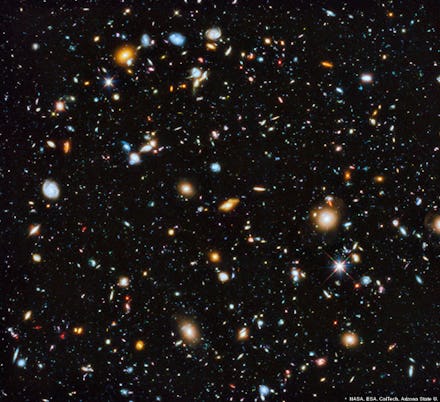This Is the Absolute Best Image of the Universe We've Ever Taken

The news: The Hubble Space Telescope has been bringing us incredible images of space for over 20 years — but it still has the ability to take our breath away.
On Tuesday, NASA released an image the agency is calling the "most colorful view of universe captured by space telescope." Captured by the Hubble over a series of 841 orbits, the composite image depicts around 10,000 galaxies, some of which formed only a few hundred million years after the Big Bang.
Check out the starry glimpse below:
Image Credit: NASA
Here's how they captured it: The section photographed above is called the Hubble Ultra Deep Field, and it's located in the Southern Hemisphere constellation Fornax. The area was previously photographed between 2003 and 2009 using visible and near-infrared light, forming a composite picture like the one above.
But Hubble's latest image is uniquely colorful and comprehensive. Not only is it a composite of photographs taken between 2003 and 2012, but it makes use of the entire spectrum of light available to Hubble, from ultraviolet to near-infrared light. Because the hottest, biggest and youngest stars give off ultraviolet light, the new image allows astronomers to observe the formation of stars, which was not possible with earlier images.
"The lack of information from ultraviolet light made studying galaxies in the HUDF like trying to understand the history of families without knowing about the grade-school children," principal investigator Harry Teplitz of Caltech in Pasadena, California said in NASA's press release. "The addition of the ultraviolet fills in this missing range."
This is major for astronomers: While the image that Hubble captured is stunning on its own, it's also a gold mine for astronomers. Previous Hubble images have only captured galaxies that are ancient and far away, or nearby and already grown up. But the new ultraviolet information fills this crucial gap by capturing galaxies that are still in their formative stages.
"In between 5 and 10 billion years ago, when UV light was emitted, we've not had the facility to explore that range in the ultraviolet — so that's why we wanted to fill in the gap," Teplitz told Space. "To understand why that's important, it's sort of like having studied people or families by first studying infants, and then studying grown-ups after they've gone to college, but completely missing everything in between and not knowing about school."
It's also good timing for NASA. Hubble is expected to be decommissioned in the next decade, and while its successor, the James Webb Space Telescope, has the ability to capture images in infrared light, it will not have ultraviolet capabilities. This picture of space may be the first — and last — of its kind.